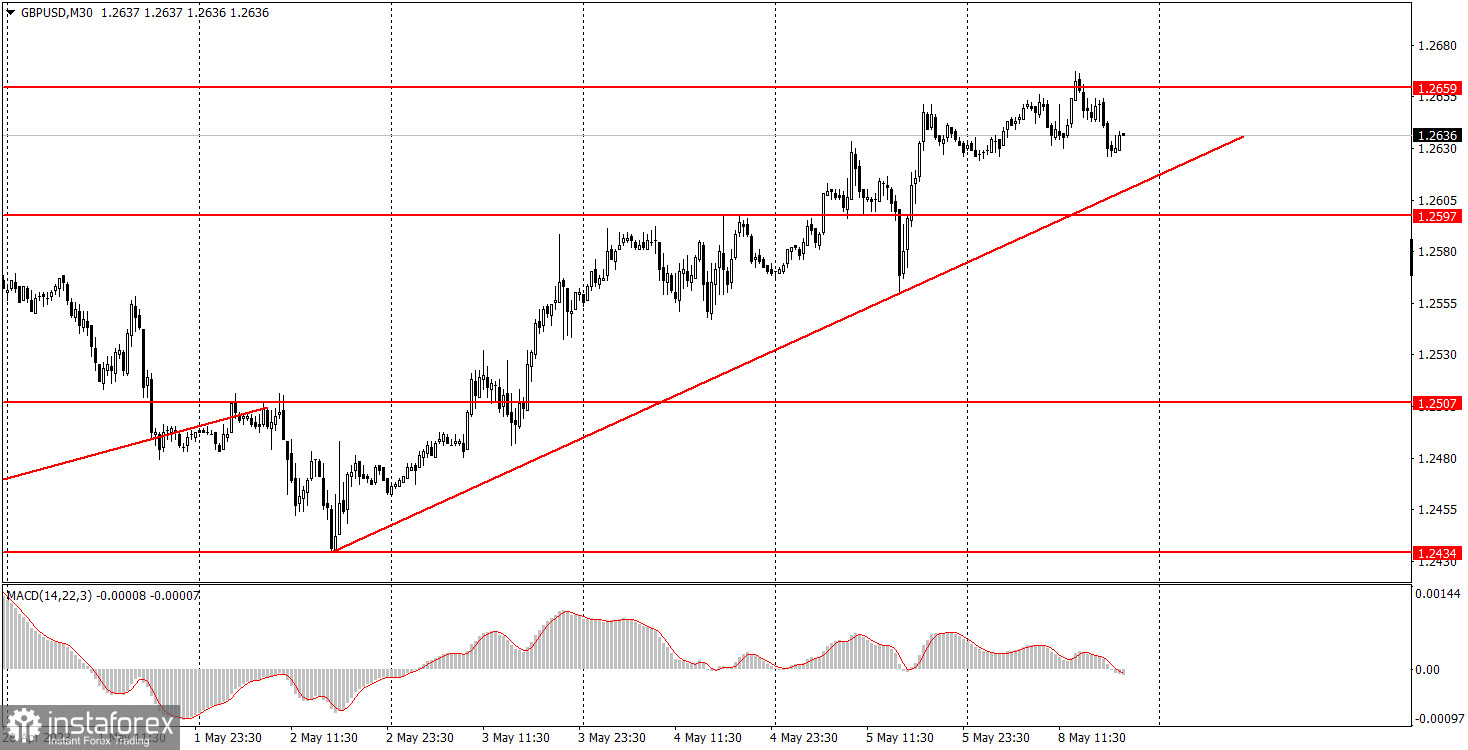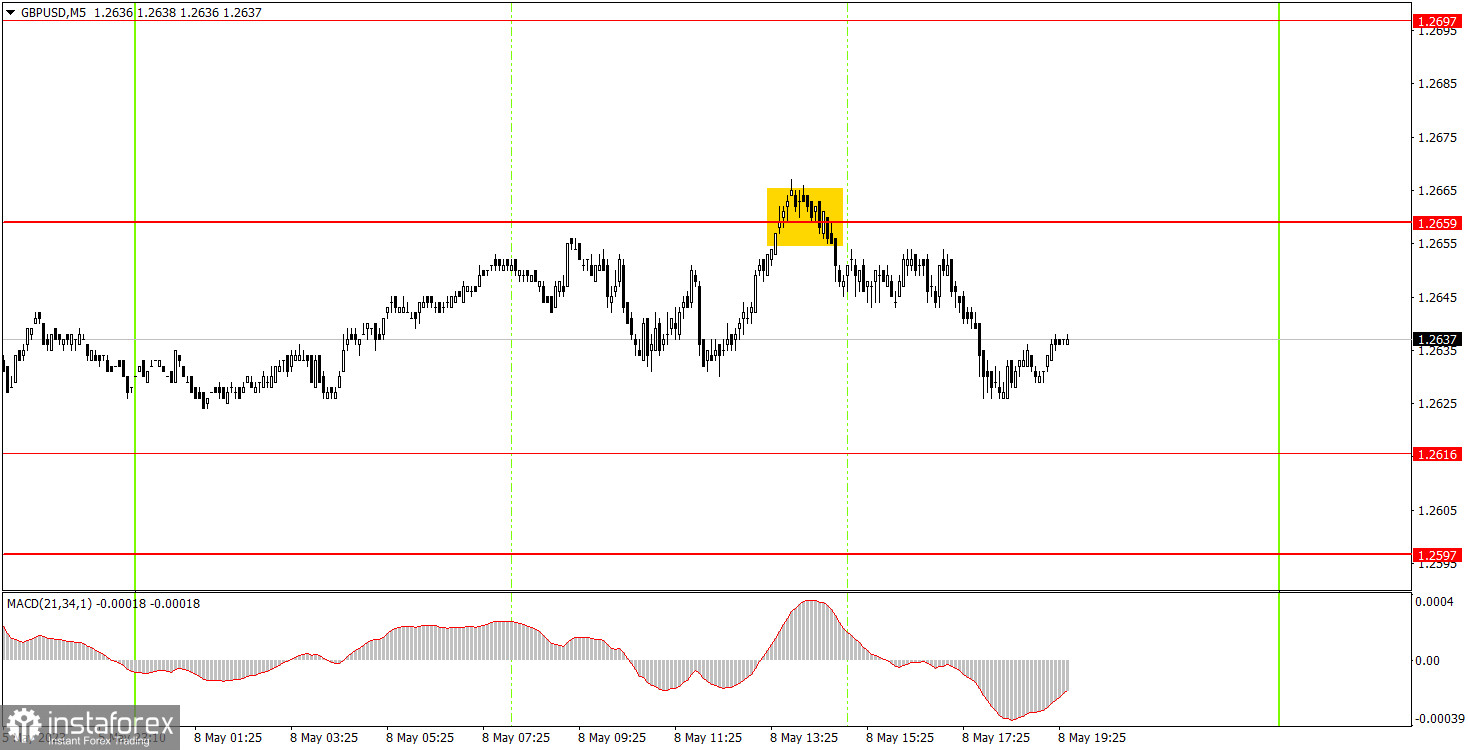Analyzing Monday's trades:
GBP/USD on 30M chart

The GBP/USD pair saw a slight correction on Monday. Although a downward pullback by a few dozen points after rising by 860 in the last two months is hardly a correction or even a pullback. It's just market noise amid an empty event calendar. There were no important reports published in either the UK or the US. Thus, the volatility equal to 45 points is easily explained. The ascending trend line (another consecutive one) remains relevant, and consolidation below it can mean anything but a further decline of the British currency. Do recall that overcoming the previous four ascending trend lines did not even lead to a correction. The pound continues to be overbought, showing illogical growth. And even if its strengthening is logical, there are no corrections, which is strange for any movement with any fundamental background.
GBP/USD on 5M chart

There won't be many trading signals on the 5-minute chart to list on Monday. Only one signal was formed around the 1.2659 level, which is not surprising with the amount of volatility for that day. It's a good thing that there was only one signal, and the movement was not completely flat, otherwise, a large number of false signals could have formed. On the sell signal, traders could open a short position, but by the end of the day, the pair failed to reach the nearest target level of 1.2616. Therefore, the position should have been closed manually with a profit of about 15 points closer to the evening. Better than nothing.
Trading tips on Tuesday:
On the 30-minute chart, GBP/USD continues to trade higher in the medium term, or at least it doesn't fall, which is clearly visible on the 4-hour chart, as well as on higher ones. The movements are mostly illogical, as is the market reaction to fundamental and macroeconomic events, which Friday proved once again. We can only observe the pound's unprecedented growth. On the 5-minute chart, you can trade at levels 1.2466-1.2477, 1.2507-1.2520, 1.2577-1.2597-1.2616, 1.2659-1.2674, 1.2697, 1.2772, and 1.2860. As soon as the price passes 20 pips in the right direction, you should set a Stop Loss to breakeven. On Tuesday, no interesting events are planned again in the UK and the US. The pair may continue to trade higher because there are no reasons and factors required for this, but there's also a high probability of a flat on Tuesday.
Basic rules of the trading system:
1) The strength of the signal is determined by the time it took the signal to form (a rebound or a breakout of the level). The quicker it is formed, the stronger the signal is.
2) If two or more positions were opened near a certain level based on a false signal (which did not trigger a Take Profit or test the nearest target level), then all subsequent signals at this level should be ignored.
3) When trading flat, a pair can form multiple false signals or not form them at all. In any case, it is better to stop trading at the first sign of a flat movement.
4) Trades should be opened in the period between the start of the European session and the middle of the US trading hours when all positions must be closed manually.
5) You can trade using signals from the MACD indicator on the 30-minute time frame only amid strong volatility and a clear trend that should be confirmed by a trendline or a trend channel.
6) If two levels are located too close to each other (from 5 to 15 pips), they should be considered support and resistance levels.
On the chart:
Support and Resistance levels are the levels that serve as targets when buying or selling the pair. You can place Take Profit near these levels.
Red lines are channels or trend lines that display the current trend and show in which direction it is better to trade now.
The MACD indicator (14, 22, and 3) consists of a histogram and a signal line. When they cross, this is a signal to enter the market. It is recommended to use this indicator in combination with trend patterns (channels and trendlines).
Important announcements and economic reports that can be found on the economic calendar can seriously influence the trajectory of a currency pair. Therefore, at the time of their release, we recommend trading as carefully as possible or exiting the market in order to avoid sharp price fluctuations.
Beginners on Forex should remember that not every single trade has to be profitable. The development of a clear strategy and money management is the key to success in trading over a long period of time.
 English
English 
 Русский
Русский Bahasa Indonesia
Bahasa Indonesia Bahasa Malay
Bahasa Malay ไทย
ไทย Español
Español Deutsch
Deutsch Български
Български Français
Français Tiếng Việt
Tiếng Việt 中文
中文 বাংলা
বাংলা हिन्दी
हिन्दी Čeština
Čeština Українська
Українська Română
Română

